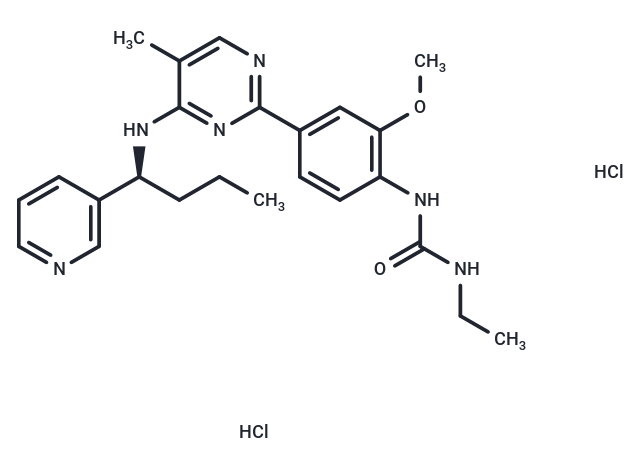Shopping Cart
- Remove All
 Your shopping cart is currently empty
Your shopping cart is currently empty

Lexibulin 2Hcl is an effective tubulin polymerization inhibitor (IC50: 10-100 nM in cancer cell lines). It also has potent cytotoxic and vascular disrupting activity in vitro and in vivo.

| Pack Size | Price | Availability | Quantity |
|---|---|---|---|
| 25 mg | $1,520 | 1-2 weeks | |
| 50 mg | $1,980 | 1-2 weeks | |
| 100 mg | $2,500 | 1-2 weeks |
| Description | Lexibulin 2Hcl is an effective tubulin polymerization inhibitor (IC50: 10-100 nM in cancer cell lines). It also has potent cytotoxic and vascular disrupting activity in vitro and in vivo. |
| Targets&IC50 | Tubulin polymerization:10-100 nM |
| In vitro | CYT997 was also capable of reversibly disrupting the microtubule network in cells, visualized using fluorescence microscopy. Thus, the treatment of A549 cells with CYT997 (1 μmol/L) leads to the rapid reorganization of microtubules, including the destruction of the existing microtubule network and accumulation of tubulin in plaques within the cytoplasm of some cells. CYT997 prevented the in vitro polymerization of tubulin (IC50: ~3 μmol/L) (compared with the half-maximal inhibitory concentration of 2 μmol/L for colchicine under identical conditions) as determined using the conventional turbidimetric assay for tubulin polymerization. Only 66% of total cells were in the G1, S, and G2-M phases, at 24 hours post-CYT997 treatment, which shows that cells blocked at the G2-M boundary do not exit back to G1, as in the normal cell cycle, but most likely are driven towards apoptosis and cell death [1]. CYT997 potently inhibits proliferation, consistent with the disruption of cellular tubulin, induces cell cycle arrest, and most importantly apoptosis of both human myeloma cell lines (HMCLs) and primary MM cells [2]. Major alterations in cell morphology were evident, after 24 hours, including loss of adhesion and cell rounding. The effect of 1 hour of treatment with CYT997 was reversible and cells rapidly recovered their normal microtubule architecture. The data indicate that CYT997 belongs to the class of anticancer agents that disrupt, rather than stabilize, tubulin-containing structures. Although vehicle-treated cells show 15% and 19% in G2-M phase at 15 and 24 hours (respectively), cells treated with CYT997 (1 μmol/L) had 38% and 43% of cells in G2-M at the same time points. |
| In vivo | A single dose of CYT997 (7.5 mg/kg i.p.) clearly decreased blood flow in liver metastases, and a significant reduction in blood flow was present 6 hours postdose [1]. CYT997 treatment (15 mg/kg/day) significantly prolongs the survival in a murine model of aggressive systemic myelomatosis [2]. In a xenograft model using the human prostate cancer cell line PC3, oral dosing of CYT997 was initiated 13 days after cell implantation by which time palpable tumors were evident. Dose-dependent inhibition of tumor growth was apparent with CYT997, which at the highest dose was equivalent to parenterally administered paclitaxel. |
| Alias | CYT-997 dihydrochloride |
| Molecular Weight | 507.46 |
| Formula | C24H32Cl2N6O2 |
| Cas No. | 917111-49-0 |
| Relative Density. | no data available |
| Storage | Powder: -20°C for 3 years | In solvent: -80°C for 1 year | Shipping with blue ice. |

Copyright © 2015-2025 TargetMol Chemicals Inc. All Rights Reserved.